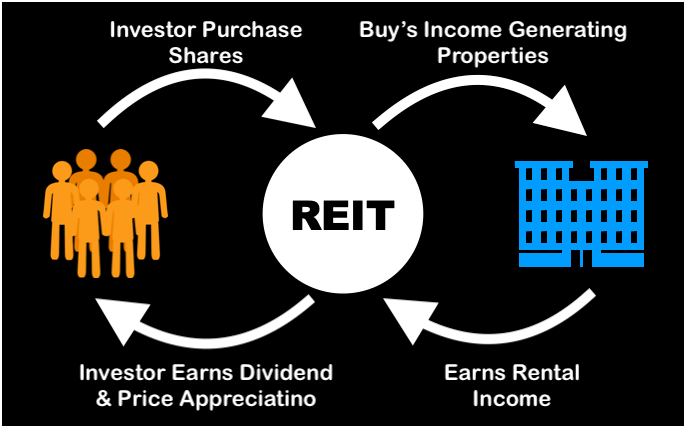REIT is a company that owns, operates or finances income producing properties (generally commercial properties) and generates incomes for its investors. REITs pool the capital from numerous investors and in return the investors earn dividends from the investments without actually going out and buying commercial real estate. REITs manage the portfolios of high valued real estate and mortgages. The real estates or assets involved in REITs can include office spaces, data centers, shopping malls, hotels, resorts, warehouses, apartments, and mortgages or loans.
An investor in a REIT
Let’s suppose that there is a REIT named ” X”. The promoters of X are going to invest some money in their pool of real estates. By investing they will get some money through rent or capital appreciation. With the new money which they have now, they would want to invest in some other real estate properties but that expansion would require even more capital. This is where X decides to come with an IPO to raise money from its investors. In return an investor will get a portion or “units” of the investments made by the trust. So now in the space pooled by X, there are companies who are going to use the space and therefore pay rent to X. Those rents will be further distributed to the investors in the form of dividends.

Types of REIT
- Equity REITs
These are popular REITs which own and manage income generating properties. The common source of income is rents.
- Mortgage REITs
These kinds of REIT operate through lending money to real estate owners or operators through direct loans or indirectly through mortgage backed securities. They mainly generate income through interest acquired through lended money.
- Hybrid REITs
This form of REITs are a combination of Equity and Mortgage REITs hence provides a diversified portfolio to its investors. In this type of REIT both interest and rent forms the basis of income
- Publicly traded REITs
The REITs are publicly listed on a national security exchange, from where they are bought and sold by individual investors. In the U.S they are regulated by the U.S securities and exchange commision (SEC).
- Public Non-Traded REITs
These REITs are not traded on national security exchange but are registered with the SEC. The characteristics of these REITs are they are less liquid but stable as they are not subject to market fluctuations.
- Private REITs
These REITs are not traded on national security exchange nor registered with the SEC. They are subject to only a selective list of investors.
Pros and Cons of REIT
Pros
- REIT are easy to buy and sell, providing good amount of Liquidity
- Transparency, REITs have high dividend payouts and limited retained earnings which indicates they more frequently seek funding from the market, in order to do so they have to disclose their plans on usage of the funding received. In this case the investor has the a clear idea of their investments made in the REIT
- Generation of steady stream of cash flow from dividends
- Diversification,often REITs, are distinguished as distinct asset class which have shown low correlation with sectors of the stock market, bonds or any kind of assets.
- Attractive Risk adjustment returns
Cons
- Subject to market fluctuation and risks, as REIT rely on underlying real estate prices which in turn can depend on external factors such as a recession, economic slump etc.
- High Maintenance fee
- Low growth prospect
- Lack of tax benefits , REIT incomes are taxed as regular income
Buying and selling of REIT
One can buy Publicly traded REIT through a broker provided that the REIT is listed on a major stock exchange. If you want to buy a public non-traded REIT, you can purchase it from a broker who participates in Public non-traded REITs. Other options are Mutual Funds where the investor can invest in such a fund through a Mutual Fund company or through Exchange-traded funds where the investor will have indirect ownership of properties










